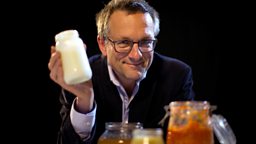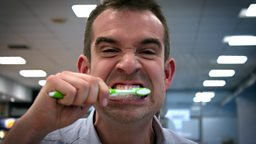Should I worry about plastics?
Plastic food packaging and plastic items are all around us.
We drink from plastic bottles, we purchase food in tins which are lined with plastic to stop metal leeching out, and even if we buy fresh food, chances are we carry it home in a plastic bag.
On top of that there’s all the plastic we’re exposed to via cleaning products like shampoos and the many plastic products we have in our homes.
However, some of the chemicals used in plastics have been linked to a range of health issues including cancer, obesity and problems with the development of the foetus in the womb.
So, should we worry about the effects of plastics on our health?
The experiment
To find out what chemicals from plastics can get into our bodies via the food we eat, Michael Mosley conducted a personal experiment.
First, he fasted for 24 hours and then he ate a meal packed full of foods and drinks that would have come into a lot of contact with plastics:
- fizzy drinks
- processed curry
- tinned fruit and vegetables
- lots of sugary snacks like jellies and ice-cream.
Samples of Michael’s urine were then sent to Dr Holger Koch at , at the Ruhr University Bochum.
Dr Koch was interested in levels of chemicals called Bisphenol A or BPA (a chemical commonly used in plastics made to contain food and drink) and different types of phthalates (a group of chemicals used to make plastics more flexible).
Once inside our bodies, our digestive system attempts to break these substances down, and the products of this reaction are called metabolites.
Dr Koch was able to measure the levels of BPA and phthalates that had got into Michael, by measuring the levels of these metabolites in his urine.
What Dr Koch found, was that, before Michael started the experiment, the levels of these chemicals in his body were in line with what is seen in most of the UK population.
After his fast, the results showed a fall in Michael’s levels of BPA and a fall in ‘high molecular weight phthalates’ but once he started eating again, these levels started to rise, showing that these chemicals were entering his body through food.
Interestingly, there wasn’t much change in the levels of what are known as ‘low molecular weight phthalates’.
This is because exposure to low molecular weight phthalates is predominantly through personal care products like shampoo and body wash.
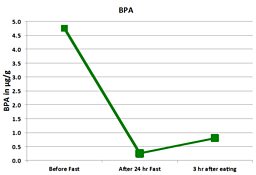
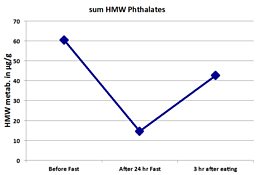
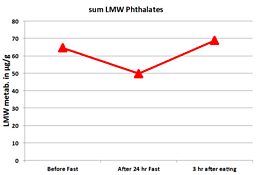
To understand whether these levels are a problem for our health Michael spoke to two leading scientists.
Dr Nick Plant
from the University of Surrey sits on the Committee on Toxicity of Chemicals in Food, Consumer Products and the Environment (COT), an independent body that advises the Food Standards Agency.

Dr Plant says that the Committee regularly look at the data and determine what levels of various chemicals are safe. They also review this information in the light of the latest scientific evidence and issue new guidance when required. Good examples of this are the revised tolerable daily intake levels of BPA set by the European Food Standards Agency in 2016 and the EU’s banning of the use of phthalates in children’s toys.
Lots of work goes into determining tolerable daily intakes. First, computer analyses, cell analyses and animal studies are used to determine the maximum level of any chemical that produces no adverse effects. This dose is then divided by 100 to give a tolerable daily intake (TDI). Because exposure to plastics can come from anything from food to footwear the Committee look at all possible sources we may be exposed to when they determine how much of each chemical it is acceptable to have in particular products.
Dr Plant acknowledges that chemicals like phthalates have been shown in high doses to have impacts on the endocrine system (the parts of the body that produce hormones) but he points to the fact that the amounts that humans are exposed to have not been proven to cause harm and that the human body can handle subtle fluctuations in hormone levels.
He also acknowledges that one unknown is how different chemicals from plastics interact with each other – often referred to as “The Cocktail Effect”. However some combinations have been studied and these are used to model other chemicals where possible to determine the various safe levels.
Dr Plant welcomes the fact that the public often put pressure on regulators to look at potential concerns surrounding the chemicals in plastics. However, he feels that at the moment many of the studies that suggest these chemicals are causing us health problems aren’t clear enough. This is because they are based on epidemiological studies (population studies that analyse patterns and factors affecting health) where there can be lots of factors at play. For instance, exposure to plastics chemicals is closely related to diet, in particular to the consumption of less healthy processed food, so there is some difficulty in determining whether any health problems that emerge are related to chemicals or to a less healthy diet in general. What’s more, as almost everyone has some level of chemical exposure, it is impossible for studies in this field to have a control group.
Prof Andreas Kortenkamp
is a Professor in Human Toxicology at Brunel University London. He thinks that while most adults with average levels of these chemicals in their bodies do not need to worry about BPA and phthalates, those who have higher levels in their bodies might have cause for concern.

For reasons we don’t understand, there is a small percentage of the population (about 5%) whose bodies contain levels of these chemicals that are 100 times higher than average. It could be that this is due to the way their bodies handle these chemicals. Prof Kortenkamp is also concerned about pregnant women who have high levels of these chemicals as there is evidence that they can have an impact on male foetuses.
In the womb, we are exposed to all sorts of hormones. As an adult, hormones control many of the body’s functions, but in a foetus hormones programme development. If the correct hormones don’t kick in at the right times then this can have an impact on how the foetus develops and can lead to lifelong issues.
Some studies in the USA and Europe have shown links between high levels of phthalates in the urine of pregnant women and negative impacts on male sex hormones. Prof Kortenkamp is also concerned that while we have seen regulation remove BPA from baby milk bottles, many manufacturers are moving towards using alternatives like Bisphenol-S, which studies are showing can have a similar effect at the developmental stages.
Prof Kortenkamp believes that regulations need to do more to protect those who are most sensitive to these chemicals. He thinks that regulators should be looking again at the way these chemicals are tested, particularly when it comes to the impact of the so-called “Cocktail Effect”. While traditional toxicology determines the tolerable daily intake for individual chemicals, these will not always take into account the fact that we are exposed to multiple chemicals that could combine to have a negative effect. Teams like Prof Kortenkamp’s are trying to develop new methods to look at how all these chemicals together could interact with the body, and in time, these could help to define new safer limits. But a problem he identifies at the moment, is that toxicologists cannot keep up with the pace at which new plastic chemicals are being discovered.
Can we avoid exposure to BPA and Phthalates?
Both Nick and Andreas agree that no one can avoid these chemicals entirely. We all need to eat and wash, so we are constantly exposed. Even if you prepare fresh food every day, that food is likely to have had some contact with plastics – for instance, fruit and vegetables may have been washed in a factory with plastic water hoses.
Many of these chemicals are so widespread that the environment around us has low levels - some studies have shown the presence of phthalates in soils and low concentrations have also been found in air and dust samples.
However something that we can do is reduce the risk of exposure to young children by ensuring milk bottles are BPA free and that toys are phthalate free – look for the ‘CE’ mark that indicates that a product complies with EU directives.
Michael’s conclusions
As adults, most of us probably don’t need to worry about plastics. However a small percentage of us will have higher than average amounts of these chemicals in our bodies. If you are a pregnant woman with high levels this could cause some problems to a male foetus.
While we cannot completely avoid exposure to these chemicals, we could all take steps to reduce the amount of plastics we use. This will not only reduce the amount of chemicals we are exposed to, but will also help to reduce the amount of plastic going to landfill which, when it breaks down, is likely to be contributing to the amounts of chemicals found in the air, soil and dust. Simple steps like bringing plastic bags to the shops and using ceramic and reusable cups instead of disposable ones could be a good place to start.































